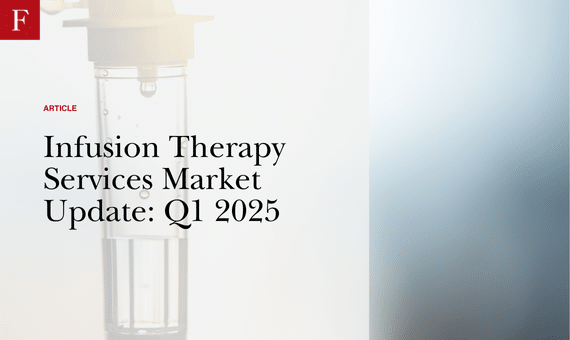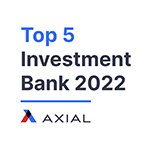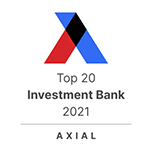
Infusion Therapy Services Market Update
Investments in the infusion therapy services market have increased rapidly since 2016, with no signs of slowing. In 2024, infusion therapy services reached the highest volume of deals to date, all of which were completed by private equity investors.
Driven by drug development and increasing utilization, infusion is a fast-growing sector of the healthcare ecosystem. A rise in the frequency of chronic diseases including cancer, gastrointestial diseases, and immune deficiency disorders coupled with an aging population and technological advancement is expected to further drive demand for infusion therapy.
A report from Option Care Health, a leader in infusion therapy services, values the US infusion market at $100 billion, with the US home infusion market making up $13 billion of the overall market. A second analysis from McKinsey estimates infusion services represented a $120 billion US market in 2022, expected to grow by a CAGR of about 8-10% by 2026.
This estimated expansion leaves room for increased competition and innovation in the marketplace – including significant opportunities for growth, particularly for ambulatory infusion centers and home-based infusion companies.
A Shift Away from Traditional Care Sites Drives PE Interest
Infusion therapy is increasingly being delivered outside of the traditional hospital setting, with services moving to physician offices, ambulatory infusion centers, and the patient’s home. Private equity investors see these new options as an attractive growth opportunity for an already thriving industry. Interest in alternative care settings is driven by several factors, including:
- Lower Costs: Payors are pushing for lower cost sites of care, especially vs. the hospital setting.
- Comfort and Convenience: Patients often prefer to have their infusion at home or at a retail-type ambulatory infusion center.
Hospitals are the most traditional site for infusion therapies, but they come at the highest cost for payors and are less convenient and comfortable for patients. Historically, hospitals have been the preferred site for infusion services because they offer more supervision from doctors who can handle adverse drug reactions. While it is still the preferred site for some drugs and conditions that require a higher service level, alternative care sites are growing in popularity.
- Physician Office: Office-based infusion centers are the second most common infusion setting outside of hospitals, especially for certain specialties like oncology, gastroenterology, rheumatology, and neurology.
- Ambulatory Infusion Center: The market has seen the most rapid growth in ambulatory infusion centers, which are retail-type locations where specially trained nurses deliver infusions to patients. These facilities serve a broad range of conditions and deliver a broad variety of drugs.
- Home-based: Another growing alternative, home-base sites allow for a specialty nurse to visit the patient’s home to deliver the infusion.
The infusion itself consists of two work and revenue components: the pharmacy component includes the purchasing and preparation of the medication, and the nursing or delivery component includes administering the drug intravenously. Because infusion companies typically offer both services, they capture profit streams from each.
What Makes Infusion Therapy a Good Investment?
There is a general shift to more cost effective and convenient care sites across healthcare services, but the infusion therapy space offers several unique factors which are driving outsized investor interest. These include a growing demand for infusion services and visibility toward an ultimate exit route for PE investments.
- Drug Development: The drug development pipeline includes a large and growing number of infusion-delivered therapies. According to BRG, more than 60% of drugs in the development pipeline are infusion-delivered and FDA-approved infusion therapies have been increasing dramatically year-over-year. Newer drugs also tend to be safer for infusion at home or in an ambulatory infusion center. Drug manufactures understand that patients and payors prefer those sites of delivery and see value in creating drugs accordingly.
- Demographic changes: An aging population with increasing chronic diseases like obesity, diabetes and gastrointestinal issues requires a greater need for innovative drug therapies. The convenience and low cost of growth in infusion services will only increase this demand.
- Likely terminal exit points: There are several types of likely buyers for large, established infusion companies once they are built by private equity investors. This creates confidence in the market and boosts interest from investors. Potential buyers include healthcare payors and distributors who have already shown interest in similar organizations, especially those with a drug delivery component.
A Newer Opportunity Early in the Capital Cycle
Because both increased infusion volume and site of care shifts are recent developments, there has been minimal investment so far. Though the market is hot, there is still a lot of room for investors to buy privately-owned infusion companies that make up most of this fragmented space. An analysis by Option Care Health, which along with CVS Coram represents 39 percent of the market, estimates there are more than 800 privately-owned infusion companies in the US.
These factors create significant market opportunity for investors to consider buy-and-build and de novo strategies. Examples include:
- Acquiring a company providing one type of service (e.g., home-based infusion) and adding other lines of service (ambulatory infusion centers, joint ventures with physician groups to build in-office infusion suites)
- Add-on opportunities such as adding nursing services to a specialty infusion pharmacy or a pharmacy to an ambulatory infusion company
- Adding infusion services to a home health company.

An Excellent Selling Opportunity for Business Owners

It is an opportune time for privately-owned infusion companies to pursue a sale. Interest is extremely high among private equity investors—including PE-backed platforms and firms looking to make their first investments in infusion.
While many of the PE-backed organizations are smaller, regional players who are likely looking to grow and enter new markets via acquisition, larger organizations also want to add new locations, enter new markets, or add lines of service (e.g., adding home-based infusion to an ambulatory infusion center operator).
High quality companies will experience competitive sale processes, and likely very high purchase multiples. Key items that make sellers attractive include:
- Strong payor contracts and RCM
- Strong purchasing, creating drug margins
- Developed referral and patient marketing
- Strong operations
- A growth story
- Clinical quality
- Diverse service offerings (different drugs, therapies)
DOWNLOAD THE FULL ARTICLE HERE.














